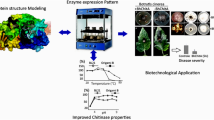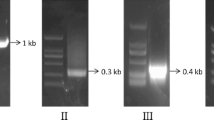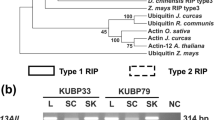Abstract
EgT2RIP is a type 2 ribosome-inactivating protein isolated from oil palm (Elaeis guineensis Jacq.). Its transcript abundance was reported to be up-regulated in oil palm roots upon inoculation of pathogenic fungus Ganoderma boninense in a recent study. This study aims to produce an active recombinant EgT2RIP protein for biological studies. The DNA fragments encoding Chain A (CA) and Chain B (CB) of EgT2RIP were cloned individually in an expression vector. Soluble CA and partially soluble CB were expressed in Escherichia coli Rosetta-gami 2 (DE3). Purified recombinant CA and CB were associated in a cysteine/cystine reduced/oxidized system, yielding a heterodimer protein (AB). The AB protein showed growth inhibitory activity against breast cancer cell lines (MCF-7) as well as non-tumorigenic breast epithelial cell line (MCF-10A) at IC50 = 1.4 and 10.9 μg mL−1, respectively. The active protein produced from this study may have the potential to be used for treatment in medical and agricultural fields.




Similar content being viewed by others
Abbreviations
- AB:
-
Heterodimers of Chains A and B
- CA:
-
Chain A
- CB:
-
Chain B
- EST:
-
Expressed sequence tag
- RIP:
-
Ribosome inactivating protein
- SDS–PAGE:
-
Sodium dodecyl sulfate–polyacrylamide gel electrophoresis
References
Endo Y, Tsurugi K (1988) The RNA N-glycosidase activity of ricin A-chain. The characteristics of the enzymatic activity of ricin A-chain with ribosomes and with rRNA. J Biol Chem 263:8735–8739
Flood J, Hasan Y, Foster H (2002) Ganoderma diseases of oil palm-an interpretation from Bah Lias Research Station. Planter 78:689–710
Frankel AE, Burbage C, Fu T, Tagge E, Chandler J, Willingham MC (1996) Ricin toxin contains at least three galactose-binding sites located in B chain subdomains 1α, 1β, and 2γ. Biochemistry 35:14749–14756
Frigerio L, Jolliffe NA, Di Cola A, Felipe DH, Paris N, Neuhaus JM, Michael Lord J, Ceriotti A et al (2001) The internal propeptide of the ricin precursor carries a sequence-specific determinant for vacuolar sorting. Plant Physiol 126:167–175
Hall T (1999) BioEdit: a user-friendly biological sequence alignment editor and analysis program for Windows 95/98/NT. Nucleic Acids Symp Ser 41:95–98
Ho CL, Kwan YY, Choi MC, Tee SS, Ng WH, Lim KA, Lee YP, Ooi SE et al (2007) Analysis and functional annotation of expressed sequence tags (ESTs) from multiple tissues of oil palm (Elaeis guineensis Jacq.). BMC Genom 8:381
Horton P, Park KJ, Obayashi T, Fujita N, Harada H, Adams-Collier CJ, Nakai K (2007) WoLF PSORT: protein localization predictor. Nucl Acids Res 35:W585–W587
Li XP, Baricevic M, Saidasan H, Tumer NE (2007) Ribosome depurination is not sufficient for ricin-mediated cell death in Saccharomyces cerevisiae. Infect Immun 75:417–428
Mosmann T (1983) Rapid colorimetric assay for cellular growth and survival: application to proliferation and cytotoxicity assays. J Immunol Methods 65:55–63
Ng TB, Wong JH, Wang H (2010) Recent progress in research on ribosome inactivating proteins. Curr Protein Pept Sci 11:37–53
Petersen TN, Brunak S, von Heijne G, Nielsen H (2011) SignalP 4.0: discriminating signal peptides from transmembrane regions. Nat Methods 8:785–786
Peumans WJ, Hao Q, Van Damme EJ (2001) Ribosome-inactivating proteins from plants: more than RNA N-glycosidases? FASEB J 15:1493–1506
Reinbothe S, Reinbothe C, Lehmann J, Becker W, Apel K, Parthier B (1994) JIP60, a methyl jasmonate-induced ribosome-inactivating protein involved in plant stress reactions. Proc Natl Acad Sci USA 91:7012–7016
Sandvig K, Van Deurs B (2002) Transport of protein toxins into cells: pathways used by ricin, cholera toxin and Shiga toxin. FEBS Lett 529:49–53
Silva ALC, Goto LS, Dinarte AR, Hansen D, Moreira RA, Beltramini LM, Araújo APU (2005) Pulchellin, a highly toxic type 2 ribosome-inactivating protein from Abrus pulchellus: cloning, heterologous expression of A-chain and structural studies. FEBS J 272:1201–1210
Singh R, Ong-Abdullah M, Low ETL, Manaf MAA, Rosli R, Nookiah R, Ooi LCL, Ooi SE et al (2013) Oil palm genome sequence reveals divergence of interfertile species in Old and New worlds. Nature 500:335–339
Steeves RM, Denton ME, Barnard FC, Henry A, Lambert JM (1999) Identification of three oligosaccharide binding sites in ricin. Biochemistry 38:11677–11685
Stirpe F (2005) Ribosome-inactivating proteins. In: Wiley RG, Lappi DA (eds) Molecular neurosurgery with targeted toxins. Humana Press, Totowa, pp 9–29
Stirpe F (2013) Ribosome-inactivating proteins: from toxins to useful proteins. Toxicon 67:12–16
Stirpe F, Battelli MG (2006) Ribosome-inactivating proteins: progress and problems. Cell Mol Life Sci 63:1850–1866
Tan YC, Yeoh KA, Wong MY, Ho CL (2013) Expression profiles of putative defence-related proteins in oil palm (Elaeis guineensis) colonized by Ganoderma boninense. J Plant Physiol 170:1455–1460
Thompson JD, Gibson TJ, Higgins DG (2002) Multiple sequence alignment using ClustalW and ClustalX. Curr Protoc Bioinform 2:2–3
Walsh TA, Morgan AE, Hey TD (1991) Characterization and molecular cloning of a proenzyme form of a ribosome-inactivating protein from maize: novel mechanism of proenzyme activation by proteolytic removal of a 2.8-kilodalton internal peptide segment. J Biol Chem 266:23422–23427
Xu H, Liu WY (2004) Cinnamomin–a versatile type II ribosome-inactivating protein. Acta Biochim Biophys Hung 36:169–176
Acknowledgments
This project is funded by RUGS Initiative 6 (Grant No: 05-02-11-1408RU). We thank the Pathology Laboratory of Malaysian Palm Oil Board (MPOB, Malaysia) for providing the G. boninense PER71. Yung-Chie Tan was supported by Ministry of Science, Technology and Innovation (MOSTI) Malaysia under the National Science Fellowship (NSF).
Author information
Authors and Affiliations
Corresponding author
Ethics declarations
Conflict of interest
Authors declare no conflict of interest.
Human and Animal Rights and Informed Consent
This article does not contain any studies with human or animal subjects performed by any of the authors.
Electronic supplementary material
Below is the link to the electronic supplementary material.
10989_2015_9485_MOESM1_ESM.docx
Supplementary material 1. Supplementary Fig. A Nucleotide sequence and deduced amino acid sequence of EgT2RIP. The predicted N-terminal signal peptide and linker peptide are underlined. The position of the putative translation termination codon is indicated by an asterisk (DOCX 17 kb)
Rights and permissions
About this article
Cite this article
Tan, YC., Ho, WY., Alitheen, N.B. et al. Cloning and Expression of Oil Palm (Elaeis guineensis Jacq.) Type 2 Ribosome Inactivating Protein in Escherichia coli . Int J Pept Res Ther 22, 37–44 (2016). https://doi.org/10.1007/s10989-015-9485-5
Accepted:
Published:
Issue Date:
DOI: https://doi.org/10.1007/s10989-015-9485-5




